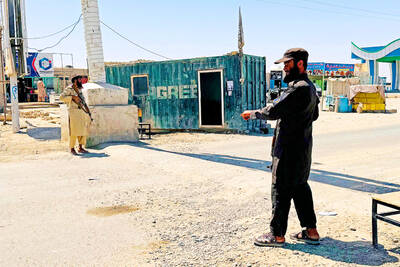The UN atomic agency said on Friday that Japan’s Onagawa nuclear power plant, despite having been closest to the epicenter of the earthquake and tsunami that struck the country last year, was in surprisingly good shape.
The structural elements of the plant were “remarkably undamaged given the magnitude of ground motion experienced and the duration and size of this great earthquake,” the International Atomic Energy Agency (IAEA) said in an initial report.
The Onagawa plant recorded temblors — “among the strongest of any plant affected by the earthquake” — that exceeded its design capacity and the basement of one of its reactor buildings flooded, but the plant maintained its cooling capacity, its reactors shut down without damage to their cores and there were no signs of major damage to crucial safety systems, the Vienna-based IAEA said.
The Fukushima Dai-ichi plant, 120km to the south, was not so lucky, suffering multiple reactor meltdowns and releasing radioactivity into the environment in the world’s worst nuclear accident in 25 years.
The IAEA report followed a two-week trip by 19 international experts that will be followed by further visits at Onagawa and reviews of other Japanese nuclear plants.
Findings will be added to an IAEA database being compiled by its International Seismic Safety Center (ISSC) that was part of the watchdog’s “action plan” on nuclear safety drawn up in the wake of the Fukushima disaster.
“The data we are collecting will make an important contribution to improving safety,” mission head Sujit Samaddar said. “Information in the database will allow IAEA member states to measure the performance of their nuclear power plants in the face of external hazards.”
In contrast, the magnitude 9.0 earthquake on March 11 last year knocked out a power line at the Fukushima Dai-ichi plant and generated a large tsunami that flooded its emergency generators, destroying the plant’s cooling systems. Catastrophic meltdowns occurred in three reactors, releasing radiation that has tainted the surrounding environment.
The plant has since stabilized, but more than 100,000 people still can’t go home due to radiation fears, while work to decommission the plant will take about 40 years. It was the world’s worst atomic accident since Chernobyl.
The Onagawa plant was about 70km from the quake’s epicenter, while Fukushima Dai-ichi was nearly 180km from the epicenter.
The tsunami was more than 13m high at both nuclear plants. Fukushima Dai-ichi’s seawall was built to withstand a tsunami of up 5.7m. Onagawa’s seawall was nearly 14m high and survived the tsunami. It has since been extended to nearly 17m above sea level.
Investigations by the government, the parliament and private groups have found that Tokyo Electric Power Co (TEPCO) underestimated the earthquake and tsunami risks faced by its plant at Fukushima despite a history of quakes in the region. The investigations have also criticized TEPCO and government regulators, which have developed cozy relationships, for ignoring safety standards and recommendations, including those by IAEA and other groups.
The IAEA visit from July 30 to Wednesday this week was its first to the Onagawa plant since the disaster. The group inspected the plant and interviewed dozens of workers and officials to assess how its structure, systems and components responded to the quake and its violent shakings.
Samaddar said he hoped to make similar inspections at other plants in Japan to share information and improve safety at nuclear power across the world. No visits are scheduled yet and would only take place at Japan’s invitation.
Five nuclear plants total suffered some level of damage from the earthquake and tsunami, but all but Fukushima Dai-ichi were shut down safely.
In May, the last of Japan’s 50 working reactors were turned off as safety checks were carried out, but two are now back online and generating power. Despite public protests, the government is eager to restart reactors because of the ballooning cost of fuel imports to keep the power supply running.

‘EYE FOR AN EYE’: Two of the men were shot by a male relative of the victims, whose families turned down the opportunity to offer them amnesty, the Supreme Court said Four men were yesterday publicly executed in Afghanistan, the Supreme Court said, the highest number of executions to be carried out in one day since the Taliban’s return to power. The executions in three separate provinces brought to 10 the number of men publicly put to death since 2021, according to an Agence France-Presse tally. Public executions were common during the Taliban’s first rule from 1996 to 2001, with most of them carried out publicly in sports stadiums. Two men were shot around six or seven times by a male relative of the victims in front of spectators in Qala-i-Naw, the center

Incumbent Ecuadoran President Daniel Noboa on Sunday claimed a runaway victory in the nation’s presidential election, after voters endorsed the young leader’s “iron fist” approach to rampant cartel violence. With more than 90 percent of the votes counted, the National Election Council said Noboa had an unassailable 12-point lead over his leftist rival Luisa Gonzalez. Official results showed Noboa with 56 percent of the vote, against Gonzalez’s 44 percent — a far bigger winning margin than expected after a virtual tie in the first round. Speaking to jubilant supporters in his hometown of Olon, the 37-year-old president claimed a “historic victory.” “A huge hug

Two Belgian teenagers on Tuesday were charged with wildlife piracy after they were found with thousands of ants packed in test tubes in what Kenyan authorities said was part of a trend in trafficking smaller and lesser-known species. Lornoy David and Seppe Lodewijckx, two 19-year-olds who were arrested on April 5 with 5,000 ants at a guest house, appeared distraught during their appearance before a magistrate in Nairobi and were comforted in the courtroom by relatives. They told the magistrate that they were collecting the ants for fun and did not know that it was illegal. In a separate criminal case, Kenyan Dennis

The US will help bolster the Philippines’ arsenal and step up joint military exercises, Manila’s defense chief said, as tensions between Washington and China escalate. The longtime US ally is expecting a sustained US$500 million in annual defense funding from Washington through 2029 to boost its military capabilities and deter China’s “aggression” in the region, Philippine Secretary of Defense Gilberto Teodoro said in an interview in Manila on Thursday. “It is a no-brainer for anybody, because of the aggressive behavior of China,” Teodoro said on close military ties with the US under President Donald Trump. “The efforts for deterrence, for joint resilience